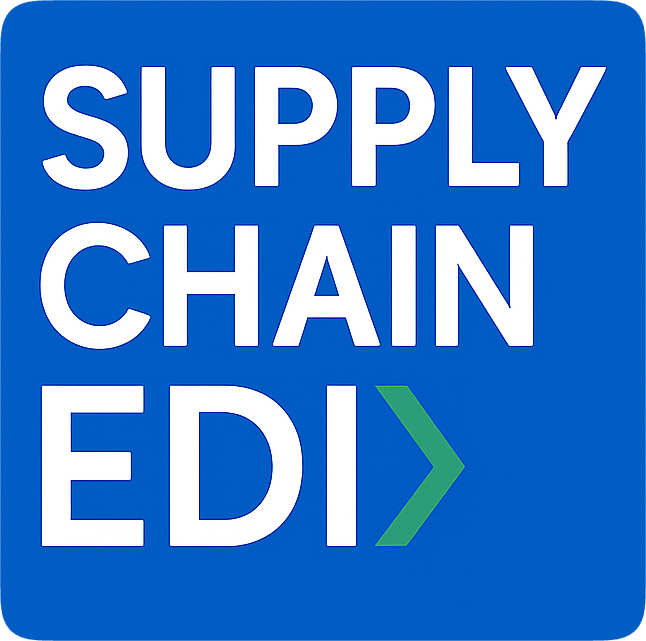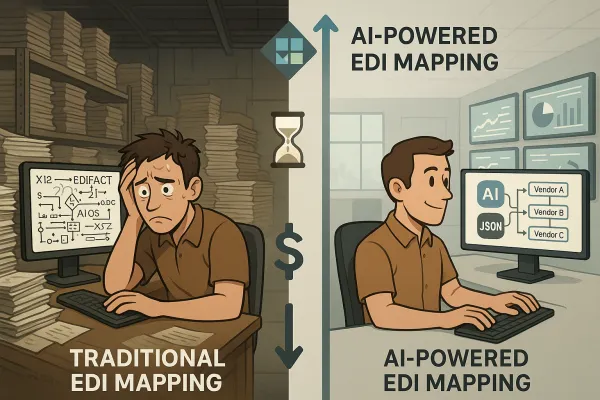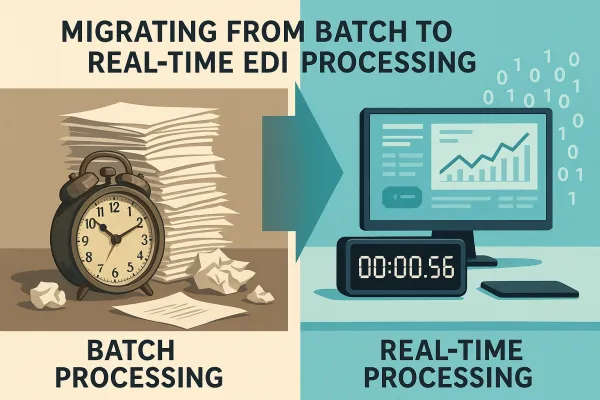The Critical EDI Skills Shortage Crisis: 5 Strategic Workforce Solutions for Supply Chain Resilience in 2025

The numbers tell a harsh story about the EDI skills shortage crisis: 29% of businesses say they lack the skilled resources to build and manage integrations between systems, applications, and partner ecosystems. Meanwhile, a lack of cloud skills costs businesses up to $258 million annually, according to the London School of Economics, and EDI professionals are commanding salary ranges between $83,265 and $113,013 according to recent market data.
The perfect storm of retiring expertise, misconceptions about EDI's future, and fierce competition from other tech roles has created a workforce crisis that demands immediate strategic action. Here's how forward-thinking supply chain leaders are addressing this challenge.
The Scale of the EDI Skills Crisis
Many of the professionals who initially implemented and managed EDI systems are now reaching retirement age, taking with them years of specialized knowledge and hands-on experience. This mass exodus of institutional knowledge coincides with recent global supply chain disruptions that have highlighted the importance of robust and scalable EDI solutions, further increasing the demand for trained professionals.
The financial impact is staggering. EDI professionals are in high demand but there is a limited supply, driving compensation packages that reflect this scarcity. Current market rates show the average salary for an EDI Specialist is $87,645 per year in United States, with the highest salary reaching $114,193 per year. Some sources report even higher figures, with the average EDI Specialist salary at $96,768 as of January 2025.
The skills gap extends beyond just technical knowledge. The lack of effective knowledge transfer within organizations exacerbates the problem, as new hires often face a steep learning curve when it comes to understanding legacy systems and the complexities of EDI implementation.
Why Traditional Hiring Approaches Are Failing
The root causes run deeper than simple supply and demand. While many universities and technical schools offer degrees in information technology, computer science, and business management, EDI is rarely a focus of these programs. As a result, few graduates enter the workforce with a specific understanding of EDI systems, protocols, and standards. Most EDI professionals learn on the job.
Newer technologies such as APIs and blockchain are becoming more prevalent in supply chain management, leading to concerns that EDI will eventually be phased out or replaced. This perception may discourage younger professionals from pursuing careers in EDI.
Competition from cloud and AI roles adds another layer of complexity. Companies like Cleo, IBM Sterling, TrueCommerce, and emerging platforms like Cargoson are all vying for the same limited pool of integration specialists, often offering competing benefits and career advancement opportunities.
Strategic Solution 1: Build Internal Training Pipelines
Investing in internal training programs and mentorship opportunities can help companies build a pipeline of EDI talent from within their own workforce. By pairing new hires with experienced professionals, organizations ensure valuable institutional knowledge is passed on.
EDI Academy provides onsite training classes designed to give a foundation of practical knowledge about EDI applications and how they apply to your business. They start with the basics and then focus on issues that are pertinent to your organization. The benefits include saving time and money by having affordable training at your facility.
Smart organizations are calculating ROI on training investments rather than hoping external hires will materialize. Consider these approaches:
- Structured learning paths from foundational concepts to advanced integration scenarios
- Hands-on mapping exercises with real trading partner requirements
- Cross-functional training that includes procurement, logistics, and IT perspectives
- Documentation of institutional knowledge before senior staff retire
The numbers support this approach. Individual webinars are $300 each at established training providers, making comprehensive internal programs cost-effective when spread across multiple employees.
Strategic Solution 2: Partner with Educational Institutions
Collaborations between businesses and academic institutions can create specialized EDI training courses or certifications as part of broader IT or supply chain management programs. These initiatives help equip the next generation with the skills needed to manage and evolve EDI systems.
The training landscape offers varied options. EDI Academy conducts webinars six consecutive business days in a row, 90 minutes daily, priced at $1,800 for comprehensive programs. Students who complete all courses and mapping exercises can become a Certified EDI Academy Professional.
Community college partnerships and apprenticeship programs offer another avenue. These programs typically run 8-24 weeks and cost between $5,000-$15,000, providing structured pathways from classroom to workplace.
Online alternatives provide flexibility for working professionals. Courses range from hundreds to thousands of dollars and take 3-12 months to complete, allowing employees to upskill without extended time away from critical projects.
Strategic Solution 3: Modernize to Reduce Skill Requirements
Modern EDI platforms are addressing the skills shortage by reducing the technical complexity traditionally required to manage integrations. Cloud-native solutions from providers like Cleo, IBM Sterling, TrueCommerce, and Cargoson offer user-friendly interfaces with built-in error notifications and transparency features that make troubleshooting more intuitive.
Cleo Integration Cloud bridges the gap from traditional EDI models to make sure you have full connectivity, visibility, and support for non-standard document syntaxes. This modernized EDI platform provides the flexibility, scalability, and comprehensive end-to-end processing power.
Key modernization strategies include:
- Self-service partner onboarding with pre-configured connectors for major retailers and suppliers
- Visual mapping tools that reduce the need for deep technical coding knowledge
- Automated testing and validation that catches errors before they impact trading partners
- Cloud infrastructure that eliminates server management complexity
These platforms don't eliminate the need for EDI expertise entirely, but they allow organizations to accomplish more with smaller, less specialized teams.
Strategic Solution 4: Outsource Critical Functions
Managed EDI services are becoming increasingly sophisticated, offering an alternative to building internal capabilities. Entrusting EDI operations to industry-leading Exchange Managed Services eliminates the need to scour hiring sites for skilled EDI professionals, reduces operational costs, and ensures compliance with trading partner requirements. It helps businesses realize the promises of EDI without the burden on internal teams.
Several engagement models work well:
- Full managed services where external providers handle all EDI operations and partner onboarding
- Hybrid models where internal teams maintain strategic oversight while outsourcing day-to-day operations
- Contract-to-hire arrangements that provide knowledge transfer as external consultants work alongside internal staff
- Project-based engagement for specific implementations or migrations
The cost equation often favors outsourcing when you factor in the fully-loaded cost of hiring and retaining EDI specialists, including benefits, training, and the risk of turnover.
Strategic Solution 5: Cross-Train Existing IT Staff
Rather than seeking pure EDI specialists, many organizations are having success cross-training existing IT professionals who already understand the business and possess complementary technical skills.
Focus areas for cross-training include:
- Business process understanding over pure technical mapping skills
- API integration alongside traditional EDI protocols
- Data transformation concepts that apply across multiple integration types
- Trading partner relationship management and communication
This approach works particularly well when combined with modern platforms that abstract much of the underlying complexity. An experienced database administrator or business analyst can often become proficient in EDI operations more quickly than learning these roles from scratch.
Transport management systems like Cargoson, along with traditional EDI platforms, offer opportunities for IT professionals to expand their skill sets while maintaining focus on business process optimization rather than purely technical implementation.
Measuring Success: KPIs for Your EDI Workforce Strategy
Effective workforce planning requires measurable outcomes. Track these key performance indicators:
- Time-to-competency metrics: How long does it take new hires or cross-trained staff to handle standard partner onboarding independently?
- Internal promotion rates: What percentage of your EDI team advanced from training programs versus external hires?
- Cost-per-hire reduction: Compare the total cost of developing internal talent versus recruiting experienced professionals
- Business continuity risk: Do you have adequate backup coverage for critical EDI knowledge areas?
- Partner onboarding speed: Are your workforce investments translating to faster trading partner implementations?
Document knowledge retention rates from your training investments. Training participants report: "I was very pleased with the way I was able to take the information provided in the training and use it to fill in the gaps where my knowledge may have been lacking. I feel more confident now that I have a better understanding".
The EDI skills shortage won't resolve itself through traditional hiring approaches. Organizations that combine internal development, strategic partnerships, platform modernization, selective outsourcing, and cross-training initiatives will build resilient integration capabilities while their competitors struggle with talent scarcity.
Start with an honest assessment of your current EDI knowledge risks, then implement a multi-pronged approach that reduces both immediate staffing pressures and long-term dependency on increasingly scarce specialist talent. The companies that act now will have sustainable competitive advantages in supply chain integration for years to come.





